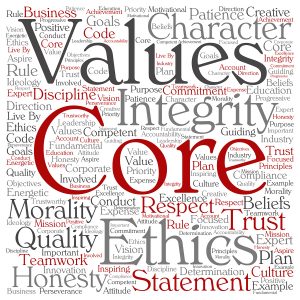Snakebit Corporate Culture
 Some know what it feels like to be in a corporate culture in the groove. The organization is in the right place at the right time with the right environment that encourages everyone to shine. We like that feeling and hope to feel it again.
Some know what it feels like to be in a corporate culture in the groove. The organization is in the right place at the right time with the right environment that encourages everyone to shine. We like that feeling and hope to feel it again.
What keeps us from having that feeling with many organizations is a corporate culture that destroys instead of builds; It discourages instead of encourages. Consequently it becomes the wrong place and the wrong time. Like venom from a snakebite, it courses through the veins of the organization. The venom causes a breakdown of the people and processes that allow us to succeed. Without eradicating the poison, it overtakes us and immobilizes us.
Avoiding the Poisonous Corporate Culture
Luckily, spotting a bad culture both as an employee and as a leader, is not hard if we step back and take a look. Before you allow your organization to fall prey to the snakebite, look for the presence of any of these symptoms.
Overly Formal Communication Channels
When just about any communication requires a memo or a broadcast email, it’s a good sign that there are some very deep problems. Sometimes, in industries where thorough documentation of processes is required, what would seem to be excessive formal communication is actually required and perhaps even regulated. In most cases, however, overly formal communication is a sign of a lack of trust and micromanagement – killers to a healthy corporate culture.
Too Many Secrets
When people aren’t talking it’s almost certainly because they are hiding something, not because they are so intent on their work. If the employees aren’t talking, you have to start asking questions such as “What are they fearful of?“, “What’s going on that they aren’t sharing?“, and as a leader “What don’t I know?”
On the management side there are those who regard information as power. Sharing information is equivalent to sharing power and some don’t want to do that. Or some simply want to leverage what they know.
Information is only truly powerful when it can used to create positive change. The more people know, the more likely they are to be part of that change.
[tweetthis]Information is only truly powerful when it can be used to bring about positive change.[/tweetthis]
Every Decision Waits on a Manager
In a poisonous culture, managers who want to maintain power and control will insist that nothing gets decided or done until they have given their OK.
I once worked for a manager who reminded me frequently to “don’t do anything. Bring it to me and I will handle it.” This despite having hired me because of my extensive experience handling precisely those types of situations. That often meant that something that could have been handled effectively in a few minutes or an hour would sometimes take a day or two. And I got bored quickly because I wasn’t really being challenged, I was carrying out whatever the boss decided whether I agreed with it or not.
Too Many Meetings
 I have worked with organizations where they had so many meetings on the schedule I actually asked them how they found time to get anything done. This kind of corporate culture bogs down many organizations in, to use an old southern phrase, they are constantly “fixin’ to get ready“.
I have worked with organizations where they had so many meetings on the schedule I actually asked them how they found time to get anything done. This kind of corporate culture bogs down many organizations in, to use an old southern phrase, they are constantly “fixin’ to get ready“.
Meetings can have distinct and useful purposes. Too often, however, we call meetings just to have “status checks”. We gather everyone in a room and one-by-one go around the table. The vast majority will say everything is fine and we have now wasted another 30 minutes to an hour of productive time.
When people have tight deadlines, places to go, family to spend time with, and lives to lead then having a lot of formal meetings becomes an annoyance and a morale killer. Find alternatives that are more efficient and less time consuming; and don’t have a meeting to flesh it out.
Rigid Adherence to Policy
In a previous post, I mentioned about a study done by Jay Hall and Telometrics on the performance of 16,000 executives. In addition to the overall conclusion of a direct correlation between achievement and the ability to care for and connect with people, they also contrasted high performers and low performers. One of their findings was that
- High performers focus on communication and collaboration and have a very participative style.
- Low performers don’t communicate well and rely on policy and procedure and have a very bureaucratic style.
Policies were created to define standard responses and consequences to situations. The flaw in that is that people and situations are not so easily defined. The result is that the responses and consequences have a great likelihood of being unevenly applied. People don’t respond well when they feel they are unfairly treated no matter how consistent it is with the policy manual.
This is also why many organizations have tossed the HR policy manual and moved towards a more values-based approach and relying on using storytelling to provide guidelines for expected behaviors.
Aggression Rules the Roost
 Have you ever had a boss proclaim “My way or the Highway!“? Then you know what we mean here. When managers and others use aggression they are trying to intimidate others into following their command or giving in. The aggressive manager wants to win at all costs, with no concern whether anyone else wins. In fact, they want you to lose.
Have you ever had a boss proclaim “My way or the Highway!“? Then you know what we mean here. When managers and others use aggression they are trying to intimidate others into following their command or giving in. The aggressive manager wants to win at all costs, with no concern whether anyone else wins. In fact, they want you to lose.
These managers are also the ones who usually hog the credit for team success, They are the ones who stare people down, tower over them, and look over their shoulders as they work.
Their impact on morale and engagement is obvious. Most people reacts to aggression with either “fight or flight”. If they fight, even when they win they lose and the aggressive manager will be that much more determined to make sure you lose the next time. If they choose flight, they go passive-aggressive, showing resistance in subtle ways, or they leave.
The Only Line is the Bottom Line
Let’s get this out of the way: there is absolutely nothing wrong with profits. I like profits. The problem is when our profit and loss are the only drivers for our corporate behavior. I mean, did you see “The Wolf of Wall Street“? Then you get the picture of the detriment of a profit first and only mindset.
So many other drivers, when we pay attention to them, have a positive impact on the profit line that we really don’t need to focus on the traditional bottom line – it will take care of itself.
Companies like Copper Leaf Creative and Patheos and others have added additional parameters of success, many ranking customer satisfaction and employee retention above the financial bottom line.


